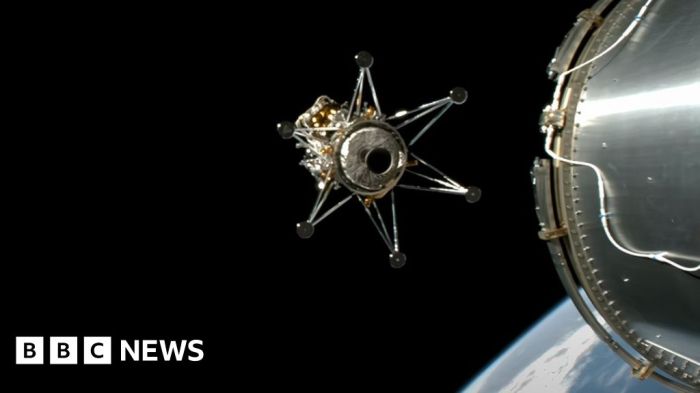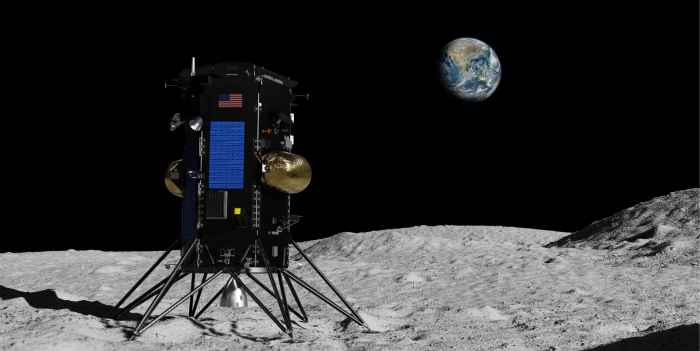Intuitive Machines makes history by landing the first commercial spacecraft on the moon, marking a pivotal moment in space exploration. This private company’s achievement signifies a shift in the lunar landscape, opening doors for new possibilities and pushing the boundaries of what we thought was possible. The successful landing of the Nova-C lander, a testament to innovation and ingenuity, ushers in a new era where commercial ventures play a significant role in shaping the future of space travel.
The moon landing is more than just a scientific feat; it’s a symbol of human ambition and the power of collaboration. This event paves the way for a future where lunar resources are explored, and the moon serves as a launchpad for further space exploration. With the commercialization of space travel, we are entering a new era of possibilities, and the moon is at the center of this exciting journey.
The Significance of Intuitive Machines’ Achievement
Intuitive Machines’ successful landing of its Nova-C spacecraft on the moon marks a pivotal moment in space exploration history. This achievement not only signifies a significant milestone for the company but also opens new doors for commercial space ventures and future lunar missions.
Historical Context and Groundbreaking Nature
The moon landing by Intuitive Machines is a remarkable feat considering the historical context of lunar exploration. While the United States and the Soviet Union were the only nations to successfully land spacecraft on the moon in the past, Intuitive Machines’ mission signifies the dawn of a new era, where private companies play a crucial role in space exploration. This achievement is a testament to the advancements in technology and the growing interest in commercial space ventures.
Commercial Implications of Private Companies Landing Spacecraft on the Moon
The commercial implications of private companies landing spacecraft on the moon are vast and far-reaching. With Intuitive Machines leading the way, a new era of lunar exploration is being ushered in, where private companies are no longer just spectators but active participants. This development opens up opportunities for various commercial activities, including:
- Resource extraction: The moon’s surface is rich in valuable resources like helium-3, which could be used as a fuel source for future fusion reactors.
- Scientific research: Private companies can establish research facilities on the moon to conduct experiments and gather data about the lunar environment.
- Tourism: The moon could become a popular destination for space tourism, with companies offering lunar trips for wealthy individuals.
Potential Impact on Future Space Exploration, Intuitive machines makes history by landing the first commercial spacecraft on the moon
Intuitive Machines’ achievement has significant implications for future space exploration. The company’s success demonstrates the viability of commercial lunar missions, paving the way for more ambitious ventures in the future. This could include:
- Establishing a permanent lunar base: Private companies could play a key role in building and maintaining a permanent base on the moon, which could serve as a platform for further exploration and scientific research.
- Developing lunar infrastructure: The establishment of lunar infrastructure, such as communication networks, power systems, and transportation systems, could facilitate future lunar missions and activities.
- Expanding human presence in space: With the moon serving as a stepping stone, private companies could contribute to the expansion of human presence in space, potentially leading to missions to Mars and beyond.
The Technology Behind Intuitive Machines’ Lunar Lander
Intuitive Machines’ Nova-C lunar lander is a testament to the ingenuity and technological prowess of modern space exploration. This remarkable spacecraft, designed to be a versatile platform for lunar missions, represents a significant leap forward in commercial spaceflight. Its innovative design and robust capabilities make it a key player in the future of lunar exploration and scientific research.
Nova-C Lander’s Key Features and Innovations
The Nova-C lander is a marvel of engineering, incorporating a range of cutting-edge technologies and innovative design elements.
- Advanced Propulsion System: The lander utilizes a powerful, high-thrust engine that enables precise landing maneuvers and efficient ascent from the lunar surface. This engine, coupled with its fuel-efficient design, allows for a significant payload capacity.
- Robust Landing Legs: Nova-C’s landing legs are designed to withstand the harsh lunar environment, ensuring a stable and secure landing on the rugged terrain. These legs are equipped with shock absorbers to minimize impact forces during touchdown.
- Autonomous Navigation and Guidance System: The lander boasts an advanced autonomous navigation system that enables it to navigate to its designated landing site with precision. This system relies on a combination of sensors, including cameras and laser rangefinders, to provide real-time information about the lander’s position and orientation.
- Integrated Communication System: Nova-C is equipped with a robust communication system that enables it to maintain constant contact with Earth throughout its mission. This system ensures reliable data transmission and allows for real-time monitoring and control of the lander’s operations.
Technical Challenges Faced and Overcome in Designing and Building the Lander
Developing a spacecraft capable of landing on the moon presents a multitude of technical challenges. Intuitive Machines faced and overcame several hurdles in the design and construction of the Nova-C lander.
- Extreme Lunar Environment: The moon’s harsh environment, characterized by extreme temperatures, radiation, and a lack of atmosphere, poses significant challenges for spacecraft design. Nova-C was designed to withstand these conditions, with its components and materials carefully selected to ensure its durability and functionality.
- Precise Landing Requirements: Achieving a precise landing on the lunar surface requires sophisticated navigation and guidance systems. The Nova-C lander’s autonomous navigation system was meticulously developed and tested to ensure accurate landing maneuvers, minimizing the risk of damage or mission failure.
- Payload Capacity and Optimization: The Nova-C lander was designed to carry a significant payload, enabling it to deliver scientific instruments, robotic probes, and other payloads to the lunar surface. This required careful optimization of the lander’s structure and weight distribution to maximize its payload capacity without compromising its performance.
- Cost-Effectiveness and Reusability: The Nova-C lander was designed with a focus on cost-effectiveness and reusability. Its modular design allows for the replacement of components, reducing the overall cost of future missions. The lander’s reusable elements contribute to a more sustainable approach to lunar exploration.
Nova-C Lander’s Capabilities and Payload Capacity
The Nova-C lander is a versatile platform capable of supporting a wide range of lunar missions. Its robust design and impressive payload capacity make it ideal for various scientific and commercial applications.
- Scientific Research: Nova-C can deliver scientific instruments to the lunar surface, enabling researchers to conduct experiments in a variety of fields, including geology, astrophysics, and planetary science.
- Resource Exploration: The lander can be used to explore the moon’s resources, such as water ice, which could potentially be used for future lunar settlements or as fuel for spacecraft.
- Commercial Applications: Nova-C can support commercial activities on the moon, such as the deployment of communication satellites, the establishment of lunar bases, or the extraction of resources.
- Payload Capacity: Nova-C has a maximum payload capacity of approximately 1,360 kg (3,000 lbs), allowing it to transport a significant amount of scientific instruments, robotic probes, or other payloads to the lunar surface.
The Future of Lunar Exploration and Commercial Spaceflight: Intuitive Machines Makes History By Landing The First Commercial Spacecraft On The Moon
Intuitive Machines’ successful lunar landing marks a pivotal moment in the history of space exploration, ushering in a new era of commercial activity on the Moon. This achievement not only demonstrates the capabilities of private companies in space exploration but also opens up exciting possibilities for future lunar missions, scientific research, and resource utilization.
Potential Applications of Intuitive Machines’ Technology
The technologies developed by Intuitive Machines for its lunar lander have broad applications in future lunar missions, paving the way for a more sustainable and diverse presence on the Moon.
| Application | Technology | Benefits |
|---|---|---|
| Lunar Base Construction | Precision landing capabilities, payload delivery systems | Efficient and accurate delivery of construction materials and equipment to designated lunar sites. |
| Scientific Research | Autonomous navigation and exploration systems, data collection and transmission capabilities | Enhanced scientific research capabilities, enabling the exploration of remote and challenging lunar terrains. |
| Resource Extraction | Robotics and automation systems, sample return capabilities | Facilitates the extraction and analysis of lunar resources, potentially leading to the development of in-situ resource utilization (ISRU) technologies. |
| Lunar Tourism | Safe and reliable transportation systems, passenger accommodation modules | Enables the development of lunar tourism ventures, offering unique experiences and promoting public interest in space exploration. |
The Role of Private Companies and Government Agencies
The successful partnership between Intuitive Machines and NASA highlights the evolving landscape of lunar exploration, where private companies and government agencies play complementary roles.
Private companies bring innovation, agility, and cost-effectiveness to lunar exploration, while government agencies provide funding, regulatory oversight, and long-term strategic planning.
Private companies like Intuitive Machines are driving technological advancements and developing innovative solutions for lunar missions, while government agencies like NASA are setting the scientific and exploration goals, ensuring the ethical and responsible use of space resources. This collaborative approach fosters a dynamic and sustainable ecosystem for lunar exploration.
Timeline of Anticipated Future Lunar Missions
The successful landing of Intuitive Machines’ lander has sparked a wave of enthusiasm for future lunar missions, with several ambitious projects already in the pipeline.
Several nations and private companies are actively developing lunar missions with diverse objectives, ranging from scientific research and resource utilization to establishing permanent lunar bases.
- 2024-2025: NASA’s Artemis III mission aims to land the first woman and the next man on the Moon, marking a significant milestone in human space exploration.
- 2025-2030: Several private companies are planning lunar missions to deliver payloads, conduct scientific research, and explore potential resource extraction sites.
- 2030-2040: The establishment of permanent lunar bases is anticipated, with plans for long-duration human presence on the Moon and the development of infrastructure for scientific research and resource utilization.
Intuitive Machines’ moon landing is a game-changer, proving that private companies can play a pivotal role in shaping the future of space exploration. This landmark achievement not only opens doors for new scientific discoveries but also signifies a shift in how we approach space travel. The potential for commercial lunar missions is vast, and the possibilities are endless. This is just the beginning of a new era, and the moon is ready to be explored like never before.
Intuitive Machines’ lunar landing is a giant leap for private space exploration, marking a new era where commercial ventures are pushing the boundaries of space travel. While this exciting development is unfolding, the tech world is also buzzing with the Amazon Fire Phone KitKat update, which brings some new features to the device. It’s interesting to see how both the public and private sectors are innovating and driving progress in their respective fields, each contributing to a future where technology continues to shape our world in unimaginable ways.
 Standi Techno News
Standi Techno News

